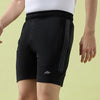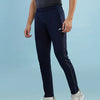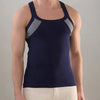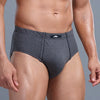Understanding the Key Differences Between Joggers and Track Pants
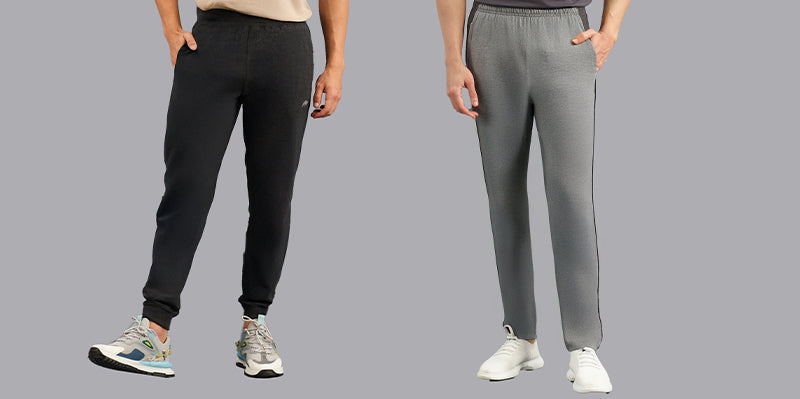
Synopsis
Joggers and track pants may appear similar, but they differ in fabric, fit, style, and function. Joggers offer a fashionable, tapered look ideal for casual wear, while track pants deliver athletic performance with looser, moisture-wicking designs. Knowing their distinctions helps you choose what fits your lifestyle best.
Defining Joggers vs. Track Pants
Joggers
Joggers are tapered trousers with elastic cuffs at the ankles, typically made from cotton blends, fleece, or jersey. They merge comfort with a modern aesthetic for athleisure style.
Track Pants
Track Pants offer a straight-leg, relaxed fit and are fashioned from synthetic fabrics like polyester or nylon. Designed for sports, they prioritize breathability, quick-drying capability, and comfort during intense activities.
Fabric: What Makes Them Different?
Joggers: Often crafted from cotton-polyester blends, fleece, or jersey—perfect for cozy, everyday wear.
Track Pants: Made from smooth, synthetic materials (e.g., polyester or nylon), focused on reducing friction and efficiently wicking away sweat.
Fit and Cut Comparison: Joggers vs. Track Pants
Joggers feature a slim-fit or tapered-leg design with elastic cuffs at the ankles. This design provides:
- A streamlined look ideal for urban and athleisure wear.
- Secure fit around the ankles, preventing fabric interference during movement.
- Enhanced mobility for low- to moderate-intensity activities.
Track pants, by contrast, offer a relaxed, straight-leg cut with open hems or zippered ankles. They provide:
- More ventilation and space for dynamic movements.
- Easy wear over cleats or sports shoes.
- A more traditional athletic silhouette, better suited for high-mobility workouts or warm-ups.
Joggers are slim and tapered with ankle cuffs, ideal for modern casual looks. Track pants are loose-fitting with open hems, best for performance and breathability.
Functional Differences: Which to Wear When?
Joggers: Best For
- Light workouts like jogging, walking, or gym sessions.
- Casual outings with a relaxed or sporty dress code.
- Cold weather, thanks to their warmth-retaining design.
- Travel or lounging, where comfort and flexibility matter.
Track Pants: Best For
- High-intensity workouts, sports practice, or drills.
- Hot/humid conditions where sweat-wicking is essential.
- Pre/post-exercise wear to maintain body temperature.
- Activities demanding full range of motion and airflow.
Style & Trend Differences
Joggers are at the heart of athleisure fashion. Style variants include:
- High-waisted or cargo joggers.
- Side zips, bold branding, or textured panels.
- Ideal for pairing with sneakers, hoodies, and crop tops.
Track Pants retain their sporty roots with:
- Side stripes, zip ankles, and glossy finishes.
- Simple silhouettes that prioritize function over fashion.
Some modern updates allow them to cross into casual streetwear but with a clear athletic DNA.
Joggers are fashion-forward with tapered fits and trendy details. Track pants are sport-specific, focusing on performance and comfort.
When to Choose Joggers or Track Pants?
| Situation | Best Choice | Why? |
|---|---|---|
| Lounging at home | Joggers | Soft, flexible, and stylish |
| Gym or light workout | Joggers | Tapered fit prevents fabric interference |
| Outdoor team sports/training | Track Pants | More ventilation and easy over-shoe wear |
| Hot or humid weather | Track Pants | Breathable synthetic fabrics |
| Casual social outing | Joggers | Trend-driven design, versatile styling |
| Cold weather | Joggers | Warm, often fleece-lined |
| Intense cardio or drills | Track Pants | Built for breathability and agility |
Choosing the Right Fit for Comfort & Style
Joggers: Great for an urban aesthetic, body-hugging comfort, and all-day casual wear.
Track Pants: Perfect for athletic performance, cool weather training, or sweat-heavy sessions.
Pro Tip: Always consider fabric, activity level, and climate. Cotton blends suit joggers for comfort; polyester blends suit track pants for performance.
Conclusion
Whether you’re dressing for performance or style, understanding the differences between joggers and track pants empowers you to make the right choice. Joggers bring fashion-forward comfort, while track pants offer athletic functionality.
By factoring in your activity, climate, and personal style, you can build a wardrobe that supports every move - on the field, at the gym, or out in the city.
FAQs
1. Are joggers and track pants the same?
No. Joggers are tapered and style-focused, while track pants have a looser fit and are built for athletic performance.
2. Can I wear joggers for workouts?
Yes—for light to moderate activities. For high-intensity sports, track pants are more functional.
3. Are track pants still in style?
Absolutely. With modern updates, many track pants now cross over into casual streetwear while keeping their sporty edge.
4. Which is better for summer?
Track pants made from moisture-wicking, breathable synthetics are best for hot weather workouts.
5. Do joggers suit all body types?
Yes, joggers are available in regular, slim, and relaxed fits, making them versatile for many body types.


 Contact Us
Contact Us
